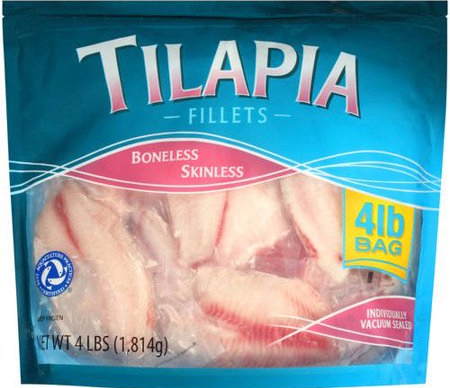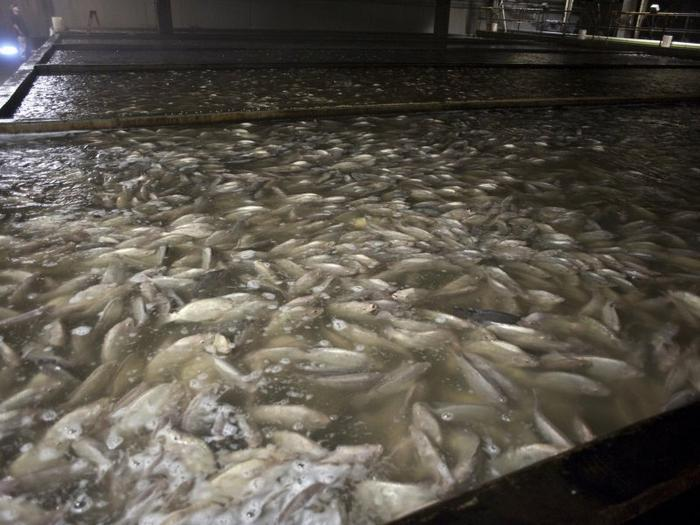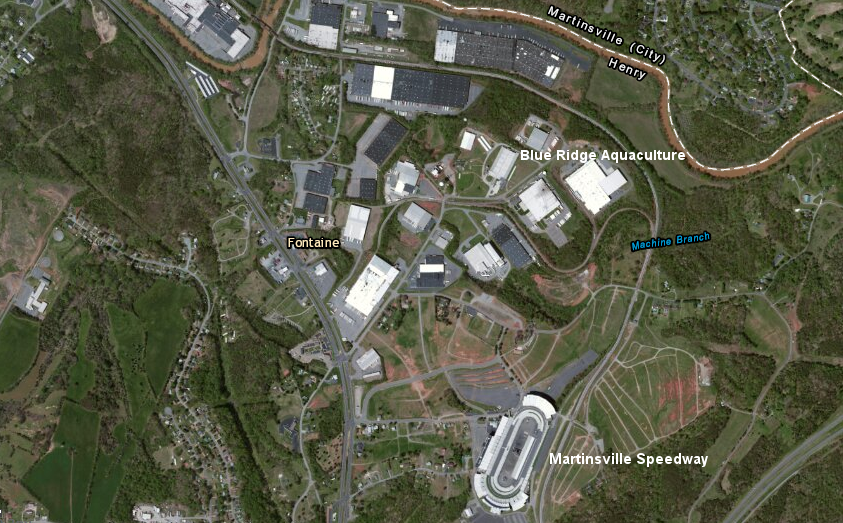
Blue Ridge Aquaculture sells fresh fish, preferred by primarily Asian and Hispanic-American customers over frozen fillets that are imported from Asia
Source: WalMart

Blue Ridge Aquaculture sells fresh fish, preferred by primarily Asian and Hispanic-American customers over frozen fillets that are imported from Asia
Source: WalMart
Blue Ridge Aquaculture near Martinsville opened in 1993. At that time, it claimed to be "the world's largest producer of tilapia using indoor recirculating aquaculture systems (RAS)."
Martinsville is not the natural habitat for growing tropical fish, but the father of the company founder had been publisher of the Martinsville Bulletin and he had worked for that newspaper. It was not his first attempt at fish farming. Before starting Blue Ridge Aquaculture, he had run a business raising catfish in tanks and selling fillets. The catfish operation had gone into bankruptcy two years earlier.1
After about 20 years of successful operation, the founder converted the business into an employee-owned company in anticipation of a new generation of managers keeping it in operation. Many of the employees had previously worked in furniture plants in Henry County or Martinsville which had closed.
By 2020 Blue Ridge Aquaculture was producing 4.5 million pounds of tilapia annually. The Chief Executive Officer was anxious to help start up other US-based fish farms using recirculating aquaculture systems, hoping to grow his isolated niche business into a nationwide industry. In 2019, tilapia imports exceeded 75 million tons, with 75% coming from China.
The price differential was significant between domestic-raise tilapia and imported fish, s0 part of the marketing strategy for Blue Ridge Aquaculture was to highlight that it sold fish grown in America. Back in 2007, frozen fillets from China cost $2/pound. Imported fresh fillets from Honduras, Costa Rica, and Ecuador sold for $5-$6/pound. Fresh fillets from American aquaculture operations were priced at $8-$10/pound.
Blue Ridge Aquaculture raises two million fish at a time in over 40 tanks. Each Wednesday, the 200 broodstock females are turned upside down into buckets, and they release 300,000-850,000 fertilized eggs which were held in their mouths for protection. The eggs grow over nine months into fish weighing at least 1.5 pounds before they are harvested.
The company sold to "primarily Asian and Hispanic-American individuals with a cultural preference for live seafood," shipping fish in trucks nightly to customers in New York, Boston or Toronto. Fish are displayed in large aquarium tanks, and customers choose the fish they want to be cut into fillets while they wait. The process maximizes freshness.
The fish eat 10 tons/day of a mix including corn, soybeans, minerals and vitamins. To ensure quality control and minimize the $2-3 million annual cost for fish food, the company expanded in 2017 and started Blue Ridge Aquafeeds in an adjacent mill.
The vegetarian diet provides the nutrients required, and tilapia normally feed on algae and plants. The mixture is softened to produce a dough-like mash, then dried and cut into noodles which resemble dog food. The fish convert the plant material into animal protein. Close management of the additives reassures customers about food safety, a marketing factor in a business in which 75% of tilapia are imported from China.
Blue Ridge Aquaculture relies upon a recirculating aquaculture system. The water coming out of the fish tanks is processed on site to remove nitrogen (ammonia) and fish poop. Oxygen is added before the water is pumped back to the fish. Recycling minimizes costs for water and sewer utility services, and makes the process more eco-friendly.

Blue Ridge Aquaculture breeds its own fish and raises tilapia in tanks, for final sale as live fish
Source: Blue Ridge Aquaculture, Tilapia
About 85% of the water was recycled initially. The additional water added daily was provided from a well drilled into the local aquifer. Groundwater was less expensive than buying drinking water from Martinsville, and avoided dealing with changing levels of chlorine and other chemicals used to make drinking water safe. Water not re-added to the tanks was sent via sewer to the Martinsville wastewater treatment plant on the Smith River.
Most US-based tilapia businesses have failed. From a business perspective, the key to tilapia growing is to be vertically integrated. Managing the production of broodstock through delivery of live fish reduces the risks of "aqua-shysters" who find opportunities to take advantage of overworked, undercapitalized fish farmers.
For example, a transportation company once claimed, suspiciously, that half the fish died on the way to market. Blue Ridge Aquaculture also caught its feed company selling bags of food that included 10% sand to inflate the weight. Aquaculturalists who dump feed directly into outdoor ponds would never discover the fraud, but the sand clogged the company's recirculating water system. That experience spurred more vertical integration with the development of Blue Ridge Aquafeeds.
The key to cost-effective production of fish within indoor tanks is to maintain temperature, water chemistry, and other conditions so the fish are not stressed. Minimizing disease minimizes loss and maximizes growth. Blue Ridge Aquaculture employed 35 people working in shifts 24-7, because aquaculture requires constant attention. The company's Chief Executive Officer said the fish made it clear when they were not happy by dying:2
Only the males, which are larger, are grown for sale. The fish convert the food put into their tanks into fish protein at the rate of 1.5 pounds of meal to 1 pound of fish, a ratio that helps fish farmers compete with pork and beef operations. Temperature and other conditions are carefully controlled.3
In 2020, Blue Ridge Aquaculture expanded with construction of a $2.5 state-of-the-art nursery facility. Tilapia normally breed twice each year, with the females protecting the developing eggs in her mouth. The aquaculture process moved the eggs daily from the mouths of females to a nursery, so female tilapia would produce a new batch of eggs every 10-14 days. The developing eggs mature in hatching tubes. Eggs stay at the bottom, while mature fingerlings rise to the top and flow into a series of 42 tanks. At 10 weeks, the fish are ready for sale.
By 2020, the company was breeding its 19th generation of fish. The control over genetics had one side benefit - the fish adapted to the steady noise of the nearby Martinsville Speedway. The earlier generations had jumped out of the tanks in response to the noises.4
The success of Blue Ridge Aquaculture may have been a positive factor in recruiting investors to develop the Pure Salmon aquaculture operation in Tazewell County. That facility, scheduled to open in 2023, will be far larger than Blue Ridge Aquaculture. The two businesses are likely to complement more than compete, since Blue Ridge Aquaculture raises tilapia and Pure Salmon will raise only salmon.5

Blue Ridge Aquaculture, the largest aquaculture operation in Virginia until development of Pure Salmon, is located far from the Chesapeake Bay in an industrial park near the Martinsville Speedway
Source: ESRI, ArcGIS Online